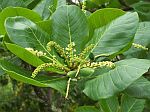







|

Plant Family: Member of the Combretaceace family; other members include Antigua Whitewood (Bucida buceras)
Description: Large, handsome, fast growing tree, attaining height of about 22 m (72 ft.); branches spreading, often in layers; leaves 15-30 cm long (6-12 in.), leathery, turning a striking yellow or red before falling, leaves shed twice a year; malodorous flowers in 15 cm spikes (6 in.), are small and white; female flowers at base of inflorescence recognized by elongated inferior ovary that gives appearance of a longer pedicel; fruit 3.5-5 cm long (1.5-2 in.), somewhat like large almond, single seeded, with fine-flavored, edible kernel, yielding an edible oil, reportedly of excellent flavor.
Natural Habitat: Coastal regions of tropics and semi-tropics; propagation by seed, which remains viable for at least one year; germination in 2-4 weeks after planting.
Origin and Distribution: Tree originally from the E. Indies, now common in tropical and semi-tropical regions, especially along coasts.
Uses:Strong, elastic timber used in construction and furniture production; roots, bark, leaves and fruit used for tanning animal skins; fruit yields a dye that can be used as ink, and seed kernel can be eaten raw or roasted; younger trees used as specimen ornamentals because of layered-branching habit and colorful leaves; medicinally: roots, bark, leaves and fruit used variously.
References:
US National Tropical Botanical Garden (ntbg.org). Kalaheo, Hawaii 2004
Dorothy P. Storer. Familiar Trees and Cultivated Plants of Jamaica, Macmillan, London 1964.
H.F. Macmillan. Tropical Planting and Gardening. Macmillan, London 1956
Robert A. DeFilipps. Useful Plants of the Commonwealth of Dominica, West Indies. Smithsonian Institution, Washington, D.C. 1998
William C. Kennard and Harold F. Winters. Some Fruits and Nuts for the Tropics. USDA, Washington, DC 1960
|



